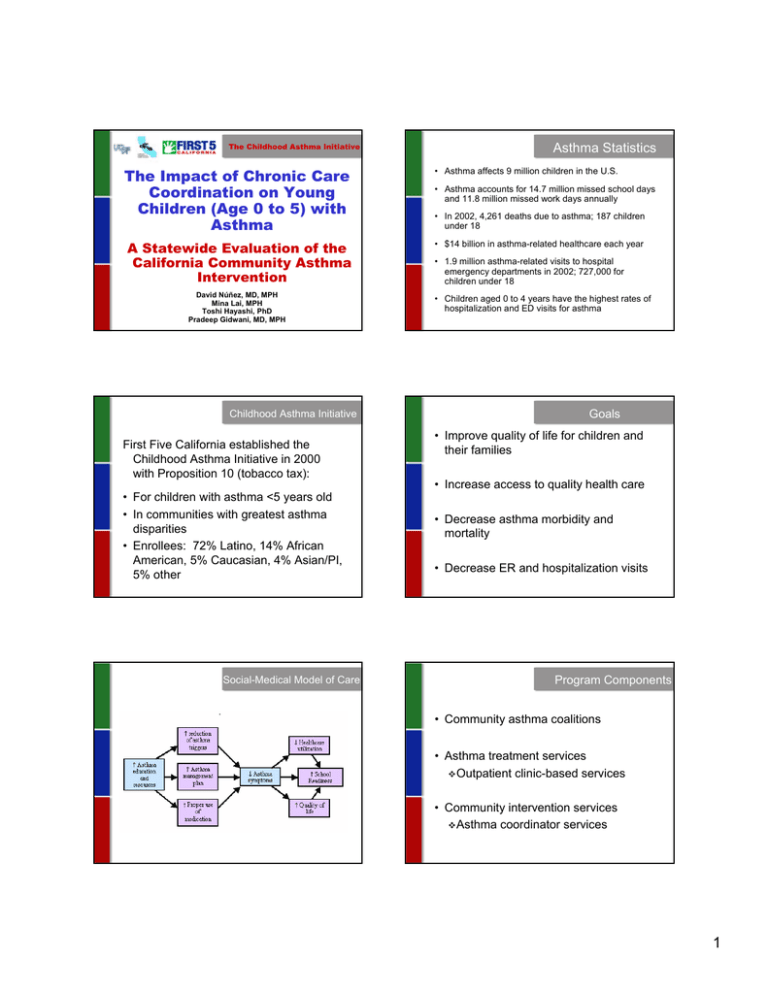The Impact of Chronic Care Coordination on Young Asthma Statistics
advertisement

The Childhood Asthma Initiative The Impact of Chronic Care Coordination on Young Children (Age 0 to 5) with Asthma A Statewide Evaluation of the California Community Asthma Intervention David Núñez, MD, MPH Mina Lai, MPH Toshi Hayashi, PhD Pradeep Gidwani, MD, MPH Childhood Asthma Initiative First Five California established the Childhood Asthma Initiative in 2000 with Proposition 10 (tobacco tax): • For children with asthma <5 years old • In communities with greatest asthma disparities • Enrollees: 72% Latino, 14% African American, 5% Caucasian, 4% Asian/PI, 5% other Social-Medical Model of Care Asthma Statistics • Asthma affects 9 million children in the U.S. • Asthma accounts for 14.7 million missed school days and 11.8 million missed work days annually • In 2002, 4,261 deaths due to asthma; 187 children under 18 • $14 billion in asthma-related healthcare each year • 1.9 million asthma-related visits to hospital emergency departments in 2002; 727,000 for children under 18 • Children aged 0 to 4 years have the highest rates of hospitalization and ED visits for asthma Goals • Improve quality of life for children and their families • Increase access to quality health care • Decrease asthma morbidity and mortality • Decrease ER and hospitalization visits Program Components • Community asthma coalitions • Asthma treatment services Outpatient clinic-based services • Community intervention services Asthma coordinator services 1 AC Services Provided • Pre-interview and post-interview with parents or caregivers • 1,920 out of 2,460 total enrollees had 2 interviews or more • Cochran-Mantel-Haenszel chi-square test used for analysis Outcome Measures Evaluation (cont.) l ho sp it a i ts m is s ed v is rk wo re ca il d ed is s m m an ag em ch en m tp pt lan om s 70 60 50 40 30 20 10 0 sy • Possession of a written asthma management plan • Hospitalizations • Emergency room visits • Childcare/preschool days, work days missed • Asthma symptoms • Quality of Life p e rc e n t Outcome measures include: ER • Basic asthma education • Assess home environment & assist in implementing environmental control measures • Instruct on proper use of medications/devices • Reinforce asthma management plan • Refer to community resources • Refer to MediCal/Healthy Families/California Kids • Coordinate care with health care providers • Coordinate care with child care providers Evaluation Entry interview Care Coordination Last interview Why does it work? In the Home: • Use asthma coordinators • Provide in-home environmental assessment and environmental control supplies In the Community: • Collaborate with other community asthma programs, policymakers, organizations Linking the clinic, home and community: • Consistent education • Consistent communication • Improves communication • Addresses cultural competency • Enables parents to be more active in child’s care • Provides social support for the family and asthmatic child • Streamlines delivery of health care services • Consistent written asthma action plan 2



